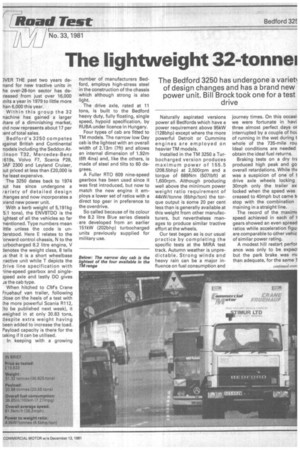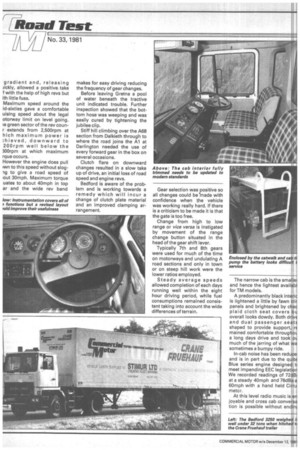The lightweight 32-tonnei
Page 23

Page 24

Page 25

If you've noticed an error in this article please click here to report it so we can fix it.
The Bedford 3250 has undergone a variet), of design changes and has a brand new power unit. Bill Brock took one for a test drive
)VER THE past two years denand for new tractive units in he over-28-ton sector has deTeased from just over 16,000 inks a year in 1979 to little more han 6,000 this year.
Within this group the 32 nachine has gained a larger ;hare of a diminishing market1 ind now represents about 17 per :ent of total sales.
Bedford's 3250 competes igainst British and Continental nodels including the Seddon At:inson T32, Mercedes-Benz I619s, Volvo F7, Scania P28, )AF 2300 and Leyland Cruiser, )ut priced at less than £20,000 is he least expensive.
The 3250 dates back to 1974 3ut has since undergone a tariety of detailed design ;hanges and now incorporates a )rand new power unit.
With a kerb weight of 5,191kg 5.1 tons), the ENV8TDO is the ightest of all the vehicles so far nentioned. Type numbers mean ittle unless the code is unlerstood. Here E relates to the brward control chassis, N to the :urbocharged 8.2 litre engine, V lenotes the weight class, 8 tells is that it is a short wheelbase :ractive unit while T depicts the Jrive line specification with line-speed gearbox and singlespeed axle and lastly DO gives JS the cab type.
When hitched to CAil's Crane Fruehauf van trailer, following ..;lose on the heels of a test with the more powerful Scania R112, to be published next week), it Neighed in at only 30.83 tons, despite extra weight having been added to increase the load. Payload capacity is there for the taking if it can be utilised.
In keeping with a growing number of manufacturers Bedford, employs high-stress steel in the construction of the chassis which although strong is also light.
The drive axle, rated at 11 tons, is built to the Bedford heavy duty, fully floating, single speed, hypoid specification, by RUBA under licence in Hungary.
Four types of cab are fitted to TM models. The narrow low Day cab is the lightest with an overall width of 2.13m (7ft) and allows an internal dimension of 1.92m (6ft 4ins) and, like the others, is made of steel and tilts to 60 degrees.
A Fuller RTO 609 nine-speed gearbox has been used since it was first introduced, but now to match the new engine it employs a lower set of ratios with a direct top gear in preference to the overdrive.
So called because of its colour the 8.2 litre Blue series diesels are developed from an earlier 151kW (202bhp) turbocharged units previously supplied for military use. Naturally aspirated versions power all Bedfords which have a power requirement above 95kW (128bhp) except where the more powerful Detroit or Cummins engines are employed on heavier TM models.
Installed in the TM 3250 a Turbocharged version produces maximum power of 155.5 (208.5bhp) at 2,500rpm and a torque of 689Nm (507Ibft) at 1,600rpm. Although producing well above the minimum power weight ratio requirement of 44kW/tonne (6bhp/ton) the torque output is Some 20 per cent less than is generally available at this weight from other manufacturers, but nevertheless manages to produce similar tractive effort at the wheels.
Our test began as is our usual practice by completing the specific tests at the MIRA test track. Autumn weather is unpredictable. Strong winds and heavy rain can be a major influence on fuel consumption and
journey times. On this occasi, we were fortunate in havi three almost perfect days or interrupted by a couple of hot of running in the wet during t whole of the 735-mile rou Ideal conditions are needed obtain the ideal fuel returns.
Braking tests on a dry trE produced high peak and go overall retardations. While thE was a suspicion of one of t drive axle wheels locking 30mph only the trailer ax locked when the speed was creased to 40mph but came tc stop with the combination maining in a straight line.
The record of the maximt speed achieved in each of 1 gears showed an even spread ratios while acceleration figui are comparable to other vehic of similar power rating.
A modest hill restart perfor ance was only to be expect but the park brake was mi than adequate, for the same 1 gradient and, releasing Jickly, allowed a positive take f with the help of high revs but ith little fuss.
Maximum speed around the id-sixties gave a comfortable uising speed about the legal otorway limit on level going. le green sector of the rev counr extends from 2,500rpm at hich maximum power is :hieved, downward to 200rpm well below the 300rpm at which maximum rque occurs.
However the engine does pull iwn to this speed without slog to give a road speed of out 30mph. Maximum torque uates to about 40mph in top ar and the wide rev band makes for easy driving reducing the frequency of gear changes.
Before leaving Gretna a pool of water beneath the tractive unit indicated trouble. Further inspection showed that the bottom hose was weeping and was easily cured by tightening the jubilee clip.
Stiff hill climbing over the A68 section from Dalkieth through to where the road joins the Al at Darlington needed the use of every forward gear in the box on several occasions.
Clutch flare on downward changes resulted in a slow take up of drive, an initial loss of road speed and engine revs.
Bedford is aware of the problem and is working towards a remedy which will incur a change of clutch plate material and an improved clamping arrangement. Gear selection was positive so all changes could be'made with confidence when the vehicle was working really hard. If there is a criticism to be made it is that the gate is too free.
Change from high to low range or vice versa is instigated by movement of the range change button situated in the head of the gear shift lever.
Typically 7th and 8th gears were used for much of the time on motorways and undulating A road sections and only in town or on steep hill work were the lower ratios employed.
Steady average speeds allowed completion of each days running well within the eight hour driving period, while fuel consumptions remained consistent taking into account the wide differences of terrain. The narrow cab is the smallei and hence the lightest availabl for TM models.
A predominantly black interic is lightened a little by fawn trir panels and brightened by chec plaid cloth seat covers bu overall looks dowdy. Both drive and dual passenger seats shaped to provide support, re mained comfortable throughoL. a long days drive and took ot. much of the jarring of what wa sometimes a bumpy ride.
In-cab noise has been reduce' and is in part due to the quite Blue series engine designed ti meet impending EEC legislation We recorded readings of 72dBi at a steady 40mph and 76dBa a 60mph with a hand held Cirru metor.
At this level radio music is en joyable and cross cab conversa tion is possible without endini le day a little hoarse.
I understand Bedford will nplement some trim changes I the near future. These ought ) include a revised instrument inicle with the rev counter relaced next to the tachograph irectly in the drivers eye line. M made a similar comment six ears ago and, I think it worth ?peating.
Future development of the lue engine is espected to give n increase in torque probably 50Nm (550Ibft) and reduced overned engine speed of about ,300 maximum.
A narrower useable rev band rill increase the need to use the ichometer for correct gearlanging and to gain the most conomical fuel returns.
The drivers suspension seat ould be adjusted to give a good Dmmand of the steering wheel nd foot pedals all of which were :latively light in operation.
Heater and ventilation conols are located within easy .:ach, are simple to understand nd work efficiently.
It took only a few minutes to ear frost from the screen and de windows after starting the ngine with the aid of a cold tart device, operated from rithin the cab at the start of the lird day.
The front hinged grille gives ccess to routine daily inspecons of oil and .coolant levels nd to steering gear, heaters and able runs. The fuse box is oused inside the cab below the
cover looks difficult and makes a good case for the non maintenance type.
Bedford has not yet succumbed to the European preference for spiggot mounted wheels and continues to use cone nut fixing.
The TM cab tilts to 60 degrees or can be held in one of several positions on the way, but first the lower grille mounted on the chassis must be lowered out of the way.
No dismantling is needed. The steering hinges with the cab and the gear shift lever is telescopic which allows full movement and keeps the floor panel in tact which is an improvement in the fight against noise ingress.
A Dynair fan included on the test vehicle is listed as an option. Temperature sensing limits its operation locking in the drive only when it is needed to provide extra cooling so making a worthwhile contribution to the vehicles overall performance.
Night driving is aided by two pairs of halogen headlamps mounted within the bumper and provided adequate on full beam but gave poor illumination of the road ahead using dipped beam.
Entry to the cab is high but steps in front of the steered axle and a grab handle located low on the A post make the climb an easy one. Dismounting is less sure as footholds cannot be seen from within the cab.
Storage facilities are minimal but door pouches are useful for document and maps etc. I would like to see provision to keep ropes, tools and oilcans in a locker built into the rear of the cab. A lip at the door openin makes it difficult to remove di from the foot well.
Summary In the early seventies Bedfor recognised the existence of gap developing in its engin range as its existing engine could not be developed to me( the 6bhp requirement at 32 tort With so many more powerft machines now operating at th weight one might be forgiven ft wondering what use the low( powered machines are put. large proportion are said to ru at about the 28 tons mark whic possibly explains why this se: tor is proportionately mor successful in a declining mark( but unaffected by the unce tainty of eventual changes i maximum weight.
Beclfords 3250 is a lightweigl even when compared wit similarly powered machine: The modest torque figures wer not discernable handicap bt nevertheless .there are plans t develop this aspect of perforn ance.
Narrow cab dimensions d not cramp the interior where a of the controls are convenient' located but instrumentation an trim are in need of improvemer to provide a brighter enviror ment.
Clutch flare adversely affecte hill performance but fuel car sumption of 38.9 lit/1 00kr (7.27mpg) and journey time must be considered good ov( this route.
Bedfords parent compam General Motors has already ir troduced its world car and moving towards the concept of world truck.
It seems that it is less expel sive to produce items of equir ment in large quantities an transport them to local assembl plant than to manufacture ther in smaller numbers where the are needed.
Bedford expects to play major role in this project provi( ing cabs and engines to a. vehicles up to the largest weigl range.
Running here at well under fl 32 ton limit the vehicle carried payload well in excess of tons. At £19,833 there can t none to match it on price.










































